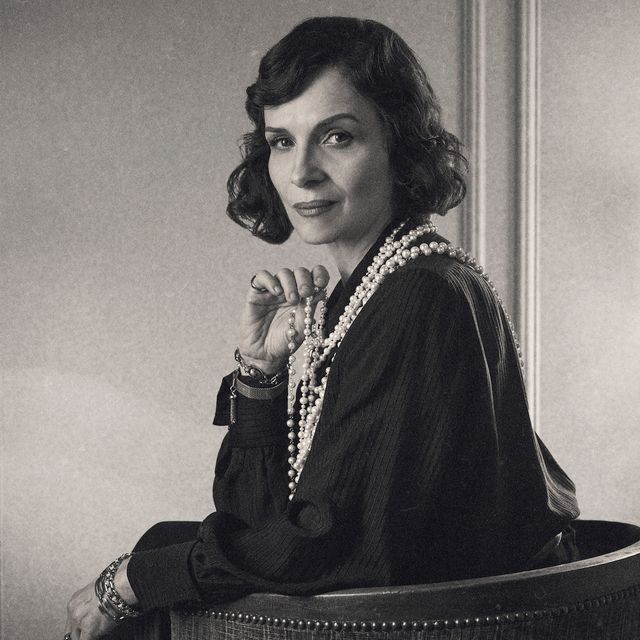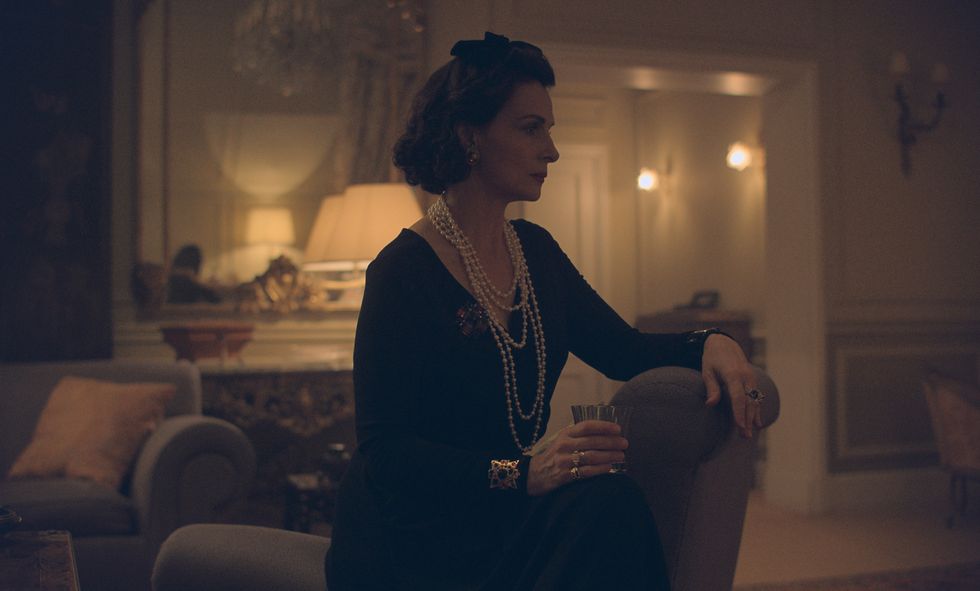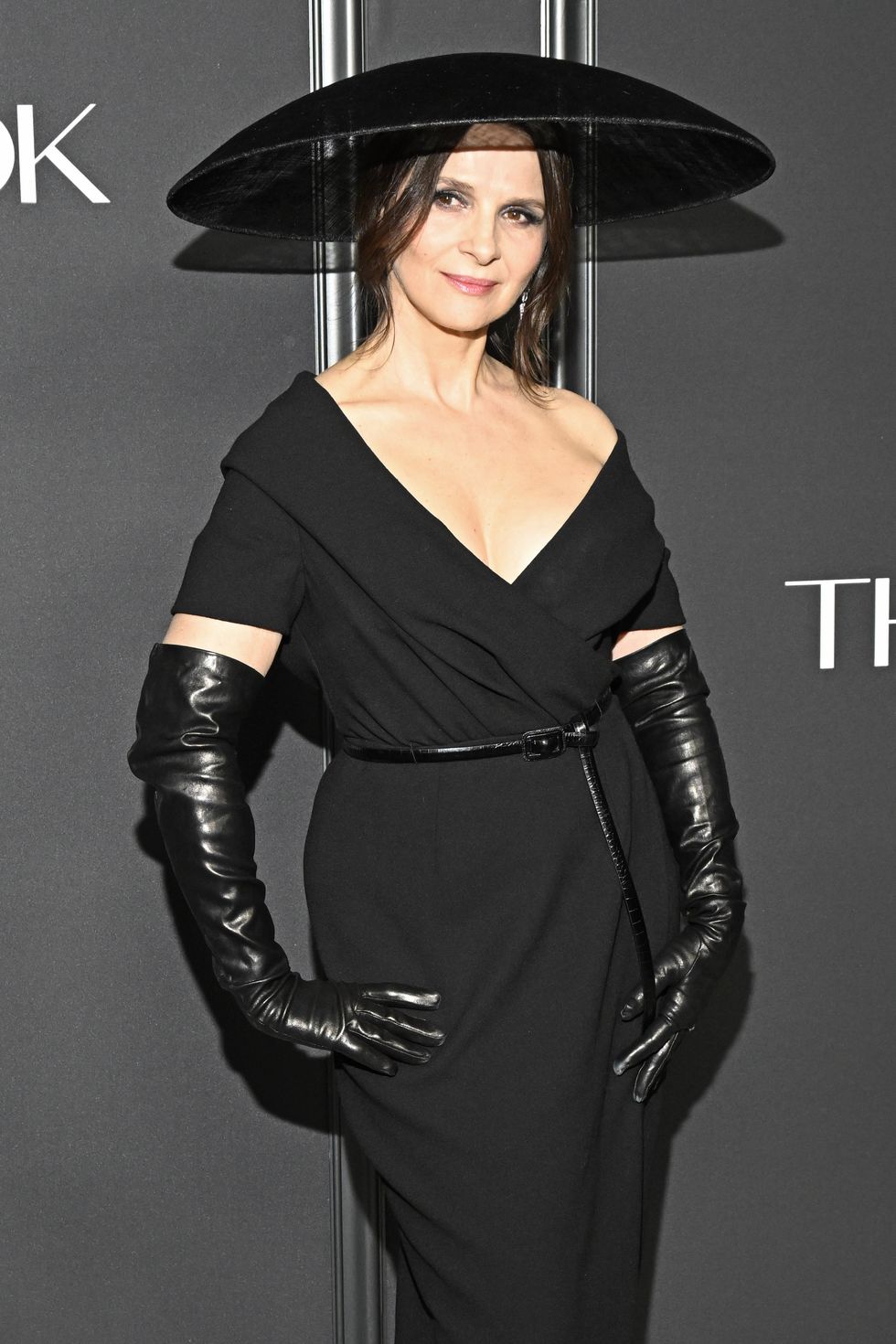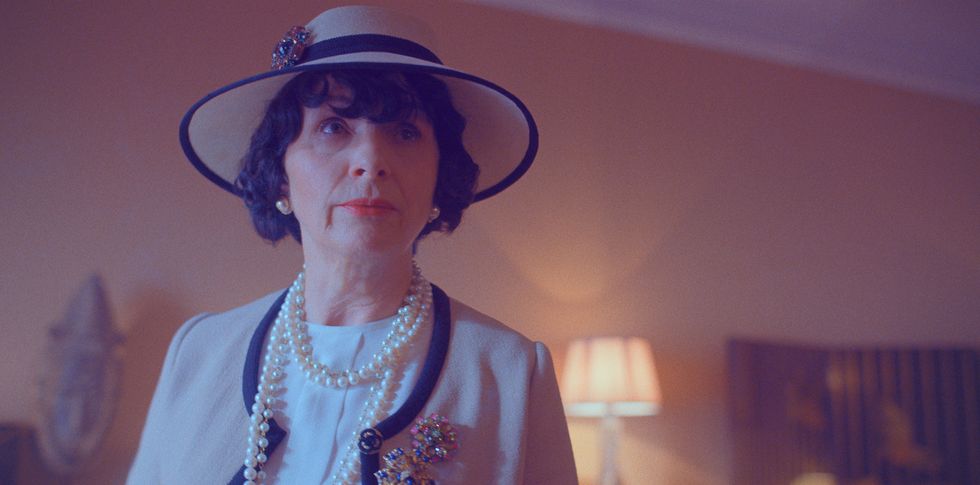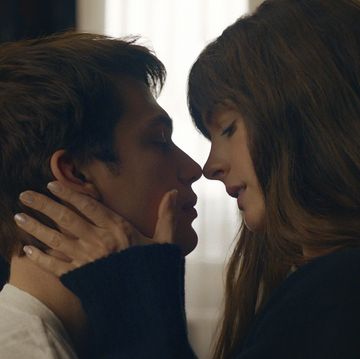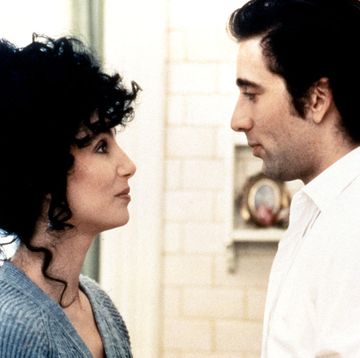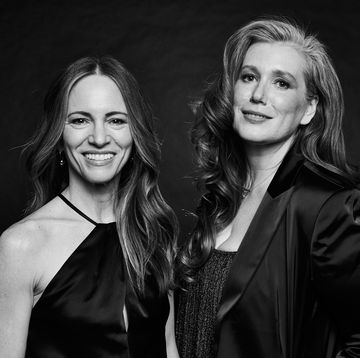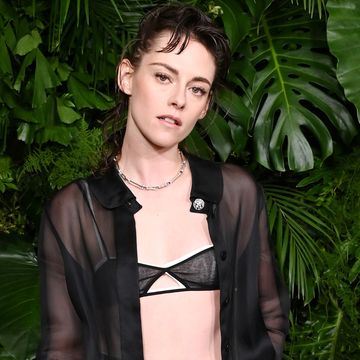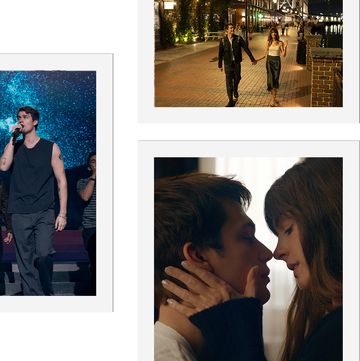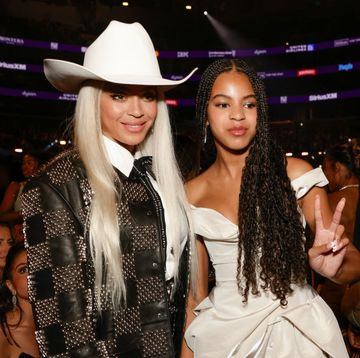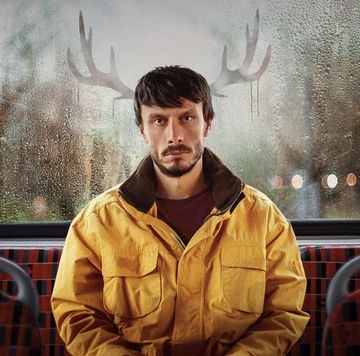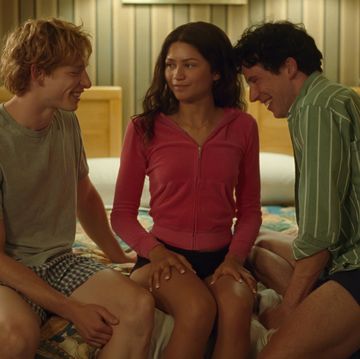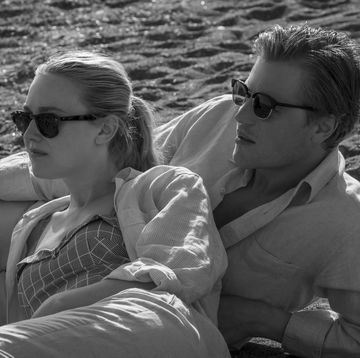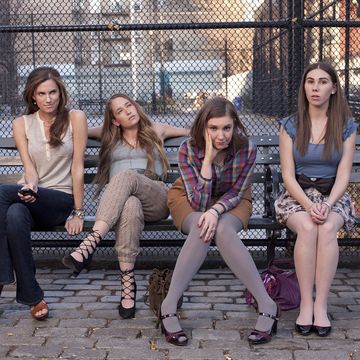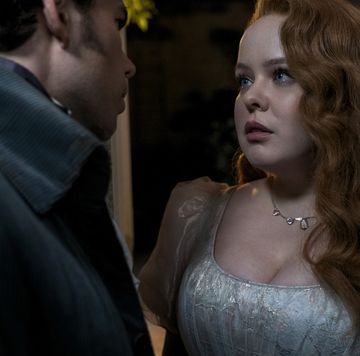Since the brand’s establishment in 1910, the name Chanel has become synonymous with luxury goods and haute couture. But in The New Look—the new Apple TV+ series dramatizing the rise of the modern fashion industry in Paris after World War II—Academy Award winner Juliette Binoche hopes to separate legendary designer Coco Chanel from the house she founded.
“What I feel responsible for is to give a human side of Chanel—not to excuse her or save her, because it is not my role—but for people to understand her, where she came from,” Binoche tells Harper’s Bazaar on a recent video call from Los Angeles. “As I was reading books and understanding where she was coming from, I could feel that there were big traumas behind [her decisions], because this need of conquering, this need of survival comes from a [personal] place.”
The New Look opens in 1955, when designer Christian Dior is preparing to speak at a conference celebrating his collections, at the Sorbonne’s Grand Ampithéâtre in Paris. Meanwhile, Chanel has recently returned from exile in Switzerland, after being accused of working with the Nazis during the war, and is primed to make her long-awaited return to haute couture. Following the liberation of France a decade earlier, Dior opened his own fashion house, debuted a legendary collection in February 1947, and eclipsed Chanel as the most famous fashion designer in the world. An embittered Chanel has criticized Dior’s focus on ultrafemininity and opulence, which she claims results in beautiful but not particularly functional dresses.
“She saw [her fashion as,] and people acknowledged it as, the creation of freedom for women in terms of what they’re wearing. She viewed Dior as, I think, setting women back,” executive producer Lorenzo di Bonaventura tells Bazaar. “What’s interesting is that [Dior] was not a guy who criticized [openly], so you don’t know so much about what he was feeling about Chanel. She was lambasting him, even after he was dead.”
It is difficult to overstate the impact Chanel and her namesake brand have had on women’s fashion. Above all else, her elegantly casual and timeless designs prioritized comfort and mobility, replacing the 20th-century corseted silhouette with sportswear. “Her jersey separates of skirts, dresses, sweaters, and cardigans liberated women from the pretenses of dressing for an occasion or for an allotted time of day,” an online exhibit by the Metropolitan Museum of Art says.
By her own admission, Binoche knew very little about Chanel before signing on to The New Look. But the actor soon became interested in digging into the “many lives” of the designer, who had a tendency to hide and spin certain facts about her life. Having already cast his former Bloodline star Ben Mendelsohn to play Dior, series creator Todd A. Kessler tells Bazaar he wanted to find a “French icon” to play Chanel. Whereas past depictions of Chanel have focused on her rise, Kessler connected with Binoche over their shared desire to paint a nuanced portrait of the designer’s life during and after the war.
For her interpretation of Chanel, Binoche worked with The New Look’s costume designer, Karen Muller Serreau, to re-create some of the designer’s most famous black-and-white and cream-colored looks. “It was very simplified, and [the periods depicted in the show were] also during the war and just after the war—not during the ’50s, like ’56 and ’57, when she came with a suit. Karen wanted, sometimes, for me to wear some of the colors,” such as pinks and light blues, Binoche says. “But the moment I got more involved, if I may say, was when I was choosing the jewels in the morning for the scenes. I think Karen was eager for me to choose, because it was my way to own my character.”
Despite casting Binoche (one of the most accomplished French actors working today) and shooting the show in Paris, the producers decided against recording any part of the 10-episode first season in French. In retrospect, Binoche says, it was “very strange and very difficult” to play Chanel without speaking in her mother tongue.
“She has a very specific voice, and I find it difficult to translate it into English. I tried to do it, and then I’m dubbing [now] in French, so it’s even more difficult to go back to the French and try to get this kind of a voice,” she says. Chanel’s very fast and pointed way of speaking is challenging to capture in English, but Binoche tried to bring the same idiosyncratic, self-educated energy to her performance, regardless of the language barrier.
With more than seven nationalities represented in the ensemble cast, Kessler says he chose to use English as the unifying language for the series’ characters and actors—a creative decision he acknowledged could be jarring to some viewers.
“It felt like it would get too confusing if some characters were speaking French and others weren’t,” says the showrunner, who did not want The New Look to be labeled “that French show.” (It should be noted, however, that there has never been a greater acceptance of subtitles than in today’s global TV and film landscape.) “We really, in essence, doubled down on the best talent, and we let that be the decision maker for what language the show should be in. It felt like that was the greatest honor that we could do to the actual people, as opposed to honoring them by speaking the language that they spoke.”
Using drawn-out flashbacks, The New Look offers a look at the decisions and moral compromises that Dior, Chanel, and their contemporaries had to make to survive the war. Dior, at the time a “nobody” working in Paris for couturier Lucien Lelong (John Malkovich), begrudgingly agrees to make dresses for the partners of Nazi officers, to support himself and his French Resistance fighter sister, Catherine (Maisie Williams). Binoche’s portrayal of Chanel, on the other hand, suggests the designer was caught between wanting to maintain her own autonomy and choosing to accede to Nazi demands as an act of self-preservation.
Unlike Dior, “Chanel clearly cut herself off from creating during the war,” Binoche explains. “When the Germans came to Paris, she closed everything. She had 4,000 seamstresses, had a factory of making cloth, and decided, ‘No way, I’m not going to work with the Germans.’ She kept her [signature perfume] No. 5 in order to make a living, to survive.”
As it turned out, though, Chanel did end up working with the enemy during the Nazi occupation of France. In 1934, she had moved into a suite at the Ritz Paris, where she would live until her death in 1971. After briefly fleeing from Paris during the Vichy period, she returned to the hotel, only to discover her suite had been requisitioned by Nazis. She moved into a smaller room, where she had a romantic liaison with a German officer, Hans Günther von Dincklage (played by Danish actor Claes Bang), which lasted until the end of the war. Furthermore, in a failed bid to become sole owner of her company, Chanel invoked the Nazis’ “Aryan laws”—which forbid Jews from owning businesses—against her Jewish partners, Pierre and Paul Wertheimer. It is also likely she used her connections to secure the release of her beloved nephew, Andre, who was being held as a prisoner of war in Germany.
French intelligence documents unsealed in the 1980s revealed that Chanel had even been tasked by Nazi leaders with brokering a secret peace deal between the Germans and the Allies, behind Hitler’s back.
“The French did not have such a great admiration for the Germans, but many of the Germans had a great admiration for Paris, including Walter Schellenberg, who is the officer who assigned her the mission,” Kessler says. “He was obsessed with movie stars; he was obsessed with good-looking, powerful people. One of his opening lines is ‘Who better to greet me and welcome me to Paris than Coco Chanel? Bigger than any movie star!’ That [scene in The New Look] is inspired by actual Schellenberg research.”
The moment is dramatized in The New Look: In 1943, a distressed Chanel convinces her socialite friend Elsa Lombardi (Emily Mortimer) to travel with her to Madrid under the pretense of opening a new boutique—only to reveal later that she is actually trying to deliver a message from the Nazis to British prime minister Winston Churchill, a friend. (Chanel’s code name was Westminster, for the famous London abbey church.) Codenamed Operation Modellhut, the mission was a bust, and Chanel was accused of collaborating with the Nazis. Her friend Churchill protected her, but Schellenberg’s testimony during the Nuremberg trials after the war ultimately revealed Chanel’s work as a Nazi agent.
The New Look poses the age-old question: Is it possible to separate the art from the artist? “Each person has to see how they want to see things,” Binoche says, refusing to take a side. “I understand the little girl who wanted to conquer. I think she got trapped in her fears, in her need of surviving, in her need of holding onto things. … When you see what she created, she’s definitely an amazing artist. But as a person, I think that she became the prisoner of her own world that she created.
“Of course, us stepping back, knowing that the war was the way it was, knowing about the concentration camps and the horrific war it was, it’s a different perspective [we are able to have today],” Binoche adds. “What was interesting for me in playing her is to come from an inside point of view, so we understand what’s going on and have another color of her life. It doesn’t mean to save her or to make her a better human being. It’s just to emotionally understand where it came from.”
The New Look is now streaming on Apple TV+. A new episode premieres every Wednesday through April 3.

Max Gao is a freelance entertainment and sports journalist based in Toronto. He has written for The New York Times, Los Angeles Times, NBC News, Sports Illustrated, The Daily Beast, Harper’s Bazaar, ELLE, Men's Health, Teen Vogue and W Magazine. Follow him on Twitter: @MaxJGao.
